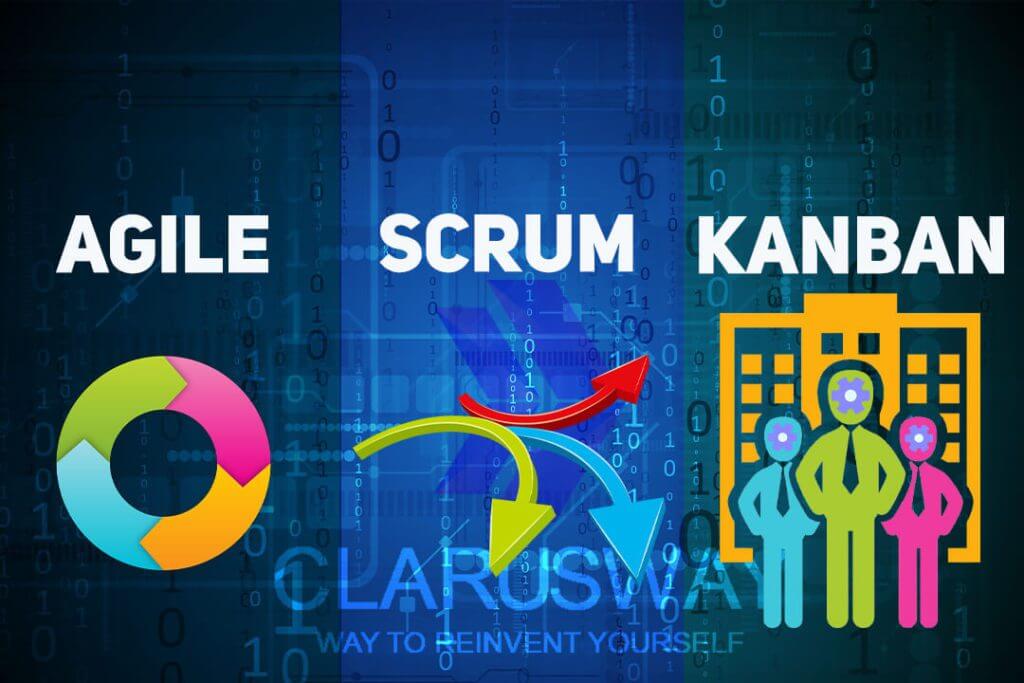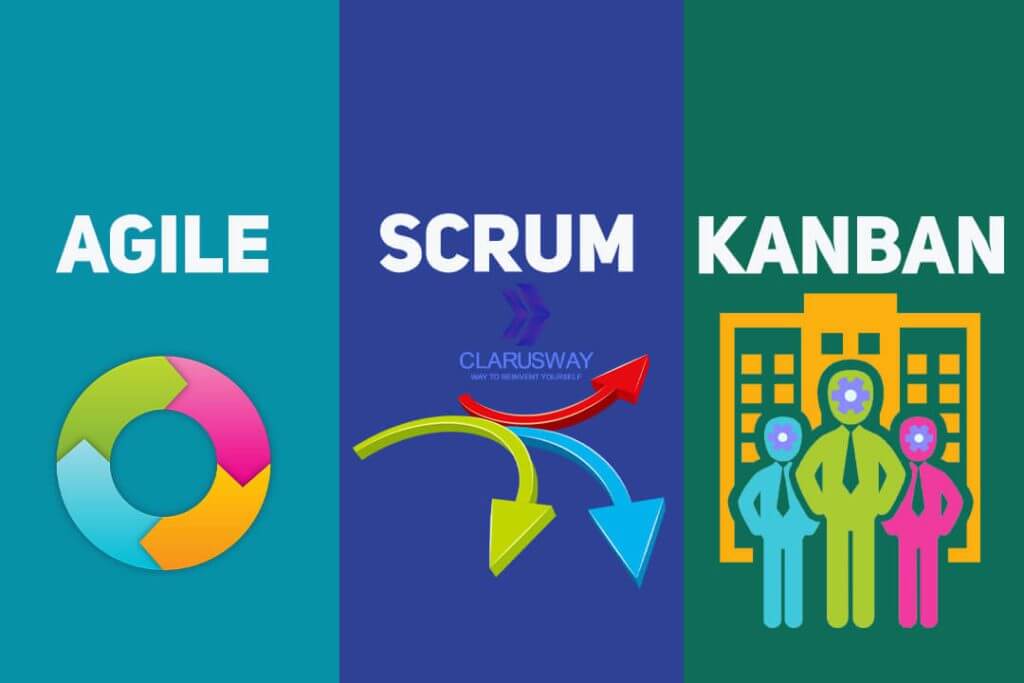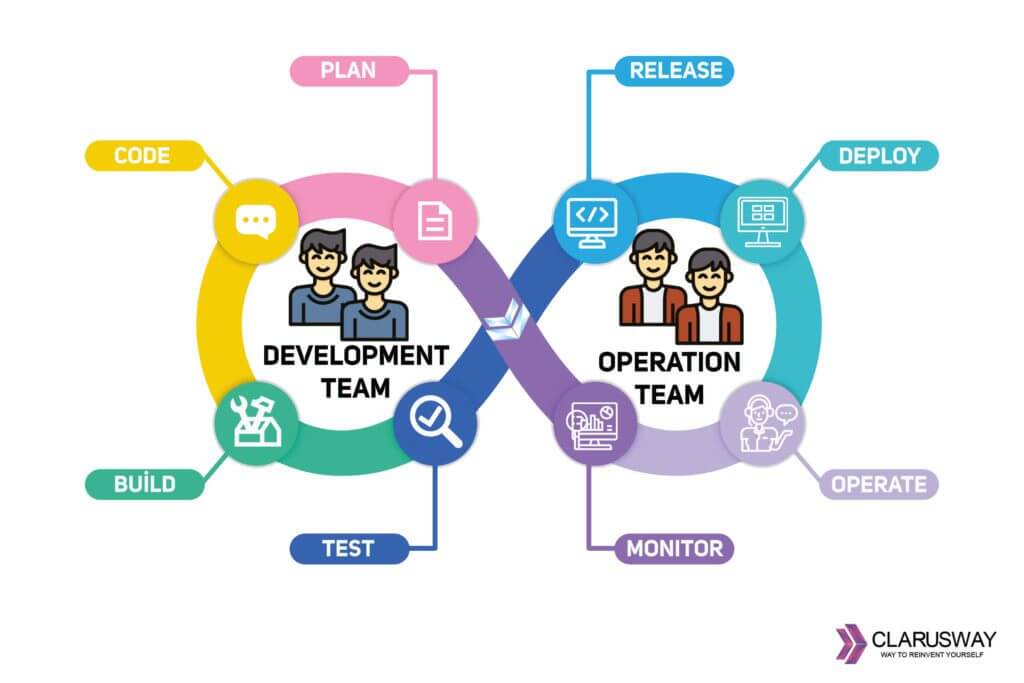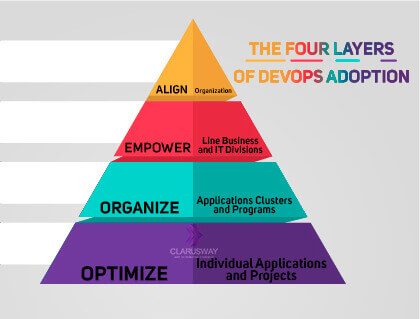DevOps is a production culture based on the philosophy of working with frequent coordination. The DevOps movement started around 2007, when developers and IT operations workers expressed frustration with the traditional path of software development, which required them to work independently on separate tasks. In response, they began to work together to develop new strategies for developing, deploying, and supporting code, in short, the DevOps job that will take shape in the future.
Let’s learn more by answering all questions about DevOps.
What is DevOps?
DevOps is the term that combines Development and Operations. This terminological unification results from the execution of development and operations processes together. Let’s first understand how it has been practiced in the past.
Two distinct teams are involved in the process of preparing an application for use: developers and operators.
The term “developer” refers to someone who creates an application. Additionally, operators deploy and maintain it on servers. There wasn’t much that needed to be updated after the application had been developed and deployed in the past years. It would take far too long for the software to adapt to changes. As a result, developers and operators were split up.

In recent years, we see that applications are constantly updated in the modern era. The redundancy of the updates necessitated the establishment of a new process culture, which resulted in the emergence of DevOps. Let’s expand on this summary a little more below.
DevOps is a set of adaptable practices and processes that businesses use to design and deliver applications and services by synchronizing and orchestrating software development with IT operations. As defined in 2009 by pioneer Patrick Debois, it is a tactical approach, not a technology. As a result, development, and operations teams can remove barriers and enhance how they create, deploy, and continuously monitor software by operating together.
In common terms, it eliminates formerly existing barriers among them in order to achieve Continuous Integration and Continuous Delivery (CI/CD) of premium software features and applications.
What is DevOps Model?
The DevOps model enables an organization to improve operational efficiency, speed up delivery, and innovate products. Increased collaboration, fluid responsiveness, and reduced cycle times are all benefits of this culture.
In other words, it splits into sections: planning and tracking, development, build and test, and delivery, as well as monitoring and operations. DevOps is unique in that it brings together development, operations, quality engineering, and security teams to optimize all tasks to launch a new product, release, or update.
There are two approaches in general: waterfall and agile, but we will focus on agile because it is widely preferred today.
Organizations can use a few common methods to accelerate and improve development and product releases based on the iterative approach, Agile. They manifest themselves in the form of software development practices and methods. Firstly let’s begin with the Agile approach then summarize the models.

Agile:
Agile is an approach that works iteratively, not grossly, to manage or develop projects and software. Thus, an agile team produces work in small but manageable increments. In addition, continuous evaluation of demands, plans, and outcomes provides teams with a failsafe mechanism for reacting quickly to change.
Unlike the traditional “waterfall” approach, Agile involves collaborating with the teams in a cross-function. Agile is based on interactions, cooperation, adaptation, and respect among team members. Therefore, agile made no mention of weekly iterations or a specific size of a team, and it simply prioritized people by outlining fundamental values.
By the way, numerous DevOps models detailed below incorporate agile programming principles. Certain agile practices, such as documenting requirements as user stories, conducting daily standups, and incorporating continuous customer feedback, are associated with increased responsiveness to changing needs and requirements. Additionally, agile promotes shorter software development lifecycles in comparison to the lengthy, traditional “waterfall” development process.
Scrum, Kanban, Lean Development, DSDM, Extreme programming, Crystal, and Feature-driven development are the usual agile models. Let’s talk about the common ones.
Scrum:
Scrum defines how team members should collaborate to accelerate development and quality assurance projects. Scrum practices include defined processes and terminology (sprints, time boxes, daily scrum [meeting]), as well as assigned roles (Scrum Master, product owner).
In addition, scrum emphasizes short, fixed-length iterations. After the sprint time frame is defined, the stories or product backlog entries implemented within this sprint cycle are determined.
Kanban:
Kanban was born out of Toyota’s factory floor efficiencies. Kanban requires that the state of work in progress (WIP) for software projects be tracked on a Kanban board.
Unlike scrum, kanban begins with a fixed number of tasks or work in progress (WIP) to be completed in the current cycle. After that, The time necessary to build these features is then computed backward.
Lean Development:
Lean development is a set of principles that can result in a one-third reduction in programming effort, budgeting, and defect rates in software development. The principles are waste elimination, amplifying learning, late decision making, fast delivery, team empowerment, built-in integrity, and view applications as a whole.
Unlike the models above, Lean focuses on improving processes, not products. Lean doesn’t seek to develop products that meet customer requirements and anticipations. It just has one way to accomplish that goal.
Furthermore, some businesses even opt for a hybrid model for the best adaption of their workflow and cycle, like “scrumban” and “kanplan”, derivated from scrum and kanban.
How does DevOps Work?
DevOps works like an across-functional mechanism. So let’s explain beginning with how it worked in the past.
In traditional software development, the development phase was completed first and then deployment operation. Especially during the code deployment, there would have interruptions because of the latent problems. By the way, that phase was getting protracted and tedium, further disagreements between development and operation teams would occur. Generally, The development teams would have blamed the server-side, but the operation team would insist on the code. When the need for updates arose, the persistence of this contention would grow at the same rate. Meanwhile, DevOps steps in and proposes a solution to these conflicts. So how?
Briefly, development and operation engineers collaborate across all processes in an entire project lifecycle (shown in the figure below).

The team collaborates on all aspects of the project, from design and development to testing automation and continuous integration (CI) to continuous delivery (CD). Individuals with development and operations skills work together and use a variety of CI-CD and monitoring tools to react quickly to customer requirements and handle issues and bugs.

DevOps engineer is the conductor of the orchestra in the lifecycle. Now it’s time to treat the lifecycle subject in the article.
DevOps Lifecycle:
The lifecycle of a developer is divided into six phases:
Source Code Management:
During this phase, the business owners and development team define the project’s objectives and development plan. Then the coders design and code the application. By the way, programmers use some tools like Git and Github to store the codes for the best management.
Continuous Build and Test:
In this phase, codes are combined from multiple repositories to build the application ultimately. For this purpose, there are tools such as Maven and Gradle. Then testing procedure conducts in automation, thanks to the Selenium, JUnit, and TestSigma vs. tools.
Continuous Integration (CI):
New features are automatically combined into the current codebase upon testing. CircleCI, Travis CI, TeamCity take part in CI process, but also some tools have CI and CD functions simultaneously.
Continuous Deployment(CD):
After the application has been released, it is packaged and deployed from the development server to the production server. Following the deployment of the software, operations teams perform tasks such as configuring servers and provisioning them with the necessary resources. DevOps engineers use CD tools such as CircleCI, Bamboo, and Buddy in this phase.
Continuous Monitoring:
Monitoring enables organizations to specify issues with particular releases and comprehend the result on end-users. Furthermore, the monitoring phase is integrated with the general management process, and the configuration management tools carry it out. But for monitoring, specifically, we point out the Chef tool.
Software Release:
In this final phase, The software is released into the market once all phases have been completed, and it meets the needs of the end-user.
Advantages of DevOps?
You got tips on the advantages previously in the article. So let’s break it down.

1. Faster Deployment:
Improved delivery of updates and features at a faster and greater frequency will not only satisfy customers. Still, it will also assist your company in establishing itself as a viable competitor in a competitive market.
2. Stabilize Working:
The stress associated with the release of new features, fixes, and updates can cause the stability of your workspace to crumble, as well as a reduction in your overall productivity. Develop a stable and well-balanced method to operate through the use of DevOps practices to improve your workplace environment.
3. Distinct Betterment in Product Quality:
Teamwork among development and operation teams improves as well as the collection of frequent user input results in a considerable improvement in the overall quality of the product and service.
4. Relief Thanks to Automation in Iterative Tasks:
Compared to the old paradigm, DevOps offers more advantages because it facilitates the detection and correction of problems more quickly and effectively. In addition, because the weaknesses are being tested over and over again through automation, the team has more time to spend on developing new ideas.
5. Enhance Your Agility:
It’s no mystery that making your company more flexible can help you remain one step ahead of your competitors. It is now feasible to accomplish the scalability required to restructure a company’s operations.
6. Continuous Software Delivery:
Under the DevOps paradigm, all departments are responsible for ensuring that the system remains stable while also introducing new features. As a result, in contrast to the previous approach, software distribution is quick and uninterruptible.
7. Speed Up Problem-Solving:
Another key benefit is the ability to provide a timely and consistent solution to technical faults in software management processes.
8. Clarity Heads To High Production:
By eliminating silo(ing) and encouraging collaboration, this technique enables more effective communication among team members, allowing them to become more focused in their specialized field of expertise. Because of this, adopting DevOps practices into a company’s operations has resulted in an increase in productivity and efficiency between the company’s personnel.
9. Minimum Production Cost:
DevOps can significantly reduce your department’s administration and production costs with good coordination, as both maintenance and new updates are consolidated under a wider single canopy.
Why is DevOps Important?
The adoption has nearly doubled in the last five years. A survey of 3,200 businesses conducted by RedGate Software: DevOps has now been embraced in some form by approximately three of enterprises (74 percent).
On the other hand, according to the 2020 DevOps Trends Survey publishment by Atlassian & CITE Research:
- 99% of respondents say It has had a positive impact on their organization
- 78% had to learn a new skill
- 48% of respondents say it helped them get a raise
- 61% say it helped them produce higher quality deliverables
- 49% say they see a faster time to market
- 49% say it improved their deployment frequency
The survey results summarize why it is important.
Is It Easy to Adopt a DevOps Model?
Changing an organization is not easy, even more so when mindset and traditions are involved. But adopting DevOps is worth it because you can modernize your software development lifecycle and deliver better products more quickly. So let’s talk about how best to do this.

To Grasp the DevOps Adoption:
Most firms struggle to get DevOps right because they view it as a framework rather than a collection of procedures or practices. It is a mindset than simply adopting the appropriate tools and technologies. The success is dependent on the coordination of cultural and technological changes in the organization.
Three more aspects are critical to fostering improved collaboration, enhancing delivery, and ensuring the success of a project.
These factors include tools, individuals, and processes. In addition, individuals involved in DevOps implementation must be trained collaboratively, and organizations must embrace digitization technologies, cloud infrastructure (with service providers, such as AWS DevOps, DevOps Azure), and current data management strategies to accelerate the adoption. In this process, hiring individuals with experience or providing expedited DevOps training to existing staff should be considered.
Along with the aforementioned factors, continuous integration and delivery (CI/CD) are often considered critical components of a successful implementation. Therefore, continuous integration and continuous delivery (CI/CD) are frequently cited as important elements of a victorious implementation.
Creating an effective pipeline to automate the build, integration, and testing processes is essential for organizations seeking to build and improve a continuous integration/continuous delivery approach and take advantage. Choosing the appropriate tools is crucial when constructing that pipeline.
To Select The Appropriate DevOps Tools:
There is no single tool that can meet all of the needs for DevOps. The most prudent course of action is selecting a collection of tools that are tailored to the organization’s software delivery environment, team, and application.
Companies can build a strong foundation, accomplish a continuous process from development to deployment, optimize resources and costs, support seamless execution of procedures, and ultimately achieve corporate goals with the help of the correct toolset.
The DevOps tools are listed briefly below. For more info, see the Clarusway blog post about Devops tools.
| DevOps Automation Tools: | DevOps CI/CD Tools: | DevOps Version Control Tools: | DevOps Configuration Management Tools: |
| Jenkins Docker Puppet Apache Maven Gradle | CircleCI Bamboo TeamCity Travis CIBuddy | Git GitHub | Chef Kubernetes Ansible Vagrant Consul Terraform Selenium Tricentis Tosca TestSigma |
Choosing the Best Processes:
Automation should be used to iterate quickly on processes in the DevOps setup. Iterative methods enable continuous feedback and guarantee that teams are always prepared to react more quickly to functional software, test constantly, and deliver it. A few items to consider when selecting the optimal process:
- From the start, obviously identified release management and continuous deployment methods help mitigate the risk of miscommunication and objective misalignment.
- Process agility enables the organization to easily absorb, test, and implement changes.
- Transparency in workflows ensures that all participating teams in the delivery process have visibility.
- Test automation can be a severe risk if not handled properly – consult external specialists as needed.
- As quality is ingrained in DevOps, it is vital to build a simple and integrated process for tracking the appropriate quality indicators and enabling continuous monitoring and validation of operational quality.
- Roles and responsibilities that are clearly defined assist team members in developing a better grasp of the processes they must follow.
- Automating the various steps of the delivery pipeline enables the total delivery process to be accelerated.
To Adapt People:
While tools and methods are critical, the people involved in the DevOps implementation process cannot be overlooked. The best way to do right is to ensure that everyone involved in the delivery cycle is more receptive to change and has an innovation mentality.
To establish DevOps as organizational culture, each individual involved in the process must be informed of their duties and responsibilities and instructed to collaborate. The leadership of the organization’s conviction in DevOps and their commitment to driving the culture is equally critical to the success.
Conclusion
DevOps assists the company in delivering high-quality software at the fastest possible pace, with the most functionality and creativity. It should be remembered that the top factors in implementing DevOps successfully are the right tools and the right people, the top factors in a DevOps team performing well are collaboration and the ability to problem-solve.
To join this growing trend, Clarusway will help you become a DevOps engineer. Just a click away!




